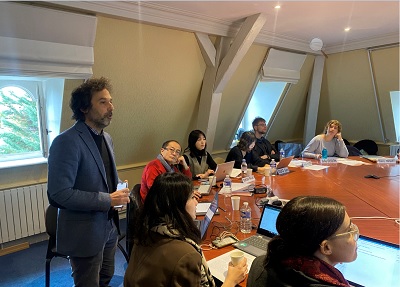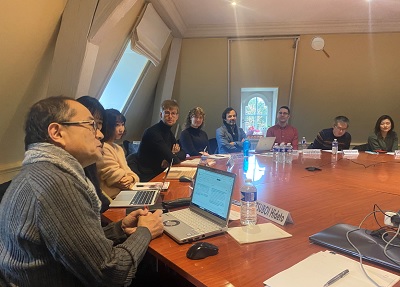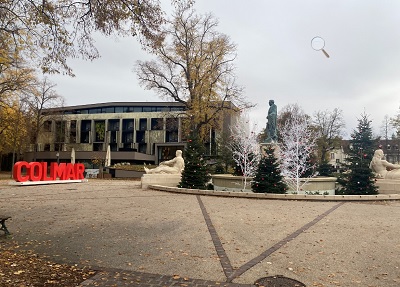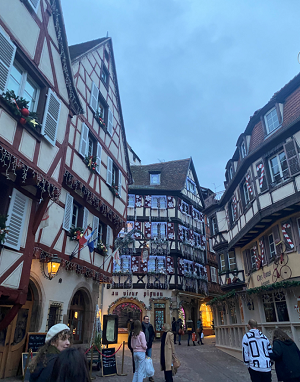Workshop Report The 6th EU-Japan Young Scholars Workshop / 2023 International New Generation Workshop(2023.11.17-19)2024/01/26
Workshop Report
The 6th EU-Japan Young Scholars Workshop in Alsace
“Transnational Change in Contemporary Japan”
「現代日本のトランスナショナルな変容」
■Organizers:
・Consortium for Global Japanese Studies (CGJS)
・Hosei University Research Center for International Japanese Studies (HIJAS)
・European Center for Japanese Studies inAlsace (CEEJA)
▶日本語レポートはこちら
Between November 17th and 19th, 2023, we held the 6th EU-Japan Young Scholars Workshop in Alsace, “Transnational Change in Contemporary Japan.” The Alsace New Generations Workshop is an international conference jointly organized by the Hosei University Research Center for International Japanese Studies (HIJAS), the European Center for Japanese Studies in Alsace (CEEJA), and the Consortium for Global Japanese Studies (CGJS). It is an intensive workshop where “early career” scholars, mainly from Europe and Japan, are invited to present and discuss their research over several days, along with keynote speakers and commentators. The workshop was online-based for a while due to the pandemic but was shifted to a face-to-face format last year, and this year, the workshop was fully conducted in a face-to-face format.
This is the third year for us to engage in the topic of “Japanese Transnationalism,” following “Japanese Studies and Transnationalism” in 2021 and “Transnationalism and Empire in Japan” in 2022. We have been continuously discussing the concept and approach of transnationalism through keynote speeches, presentations, and discussions for the past years. Although we have not yet reached a conclusion, based on our discussions, we have come up with a hypothetical methodology: searching for the form of transnational Japan. This approach aims to shed light on the characteristics of Japan by exploring the phenomena going beyond Japan. It goes without saying that it is essential for transnationalism research to empirically trace transnational phenomena and their impacts. At the same time, however, it is also vital to abstract concrete transnational cases into a more universal understanding. In the social sciences, the direction might be to generate the mechanisms, for example, of migration systems and patterns, etc. In the case of area studies, the direction of abstraction would perhaps be to generalize regional characteristics such as “Japan.” To this end, it is important to “Bringing the State Back into Transnational Studies.” People, goods, and information do not freely cross national borders, but instead, the state continues to play a role in promoting and restricting transnational mobility in various ways. The geopolitical position, policies, and ideologies of nations also shape the behavior and attitudes of their people toward transnational phenomena. Thus, by understanding the tensions between the national and the transnational, we expect to elucidate a different face of Japan that cannot be captured by looking at a country independently.
Based on such understanding, this year, we invited papers that examined (1) how transnational transformations have occurred (or are occurring) in Japan from the postwar period to the present and (2) how transnationalism is bringing about changes in the state of contemporary Japanese culture. Perhaps because of the breadth of the theme, or perhaps due to the revitalization of transnational mobility after the pandemic, we received many more applications from Japan and Europe this year than in previous years. 13 papers were selected from among the applicants, considering the diversity of fields and regions and the relevance to the theme. As a result, we were able to invite presenters from Europe (Germany, Belgium, UK, Sweden, etc.) and Asia (Japan, China, Korea), as well as from the humanities and social sciences in a wide range of academic fields (Program and Abstract).
The first day, November 17th (Friday), focused on contemporary society, with a session on “Transnational Mobility and Space” (Chair: Kei Takata). First, Kei Takata (Hosei University) gave a presentation titled “What is Transnational Japanese Studies? Based on the discussions in the previous two workshops, his talk theorized the concept of transnationalism and discussed the approach for exploring “the form of Japanese transnationalism.” Four presentations on contemporary transnational research followed his presentation, the first of which was by Nanase Shirota (Cambridge University) on the transnational migration of Japanese hostesses. She analyzed how the transnational commodification of intimacy has given Japanese women the opportunity to travel and remain abroad. However, this is a “precarious stepping stone,” and it is difficult to escape such commodification of intimacy while embedded in the racial, gender, and linguistic hierarchy of the host country, the UK. The second presenter, Miyako Hayakawa (Free University of Brussels), also analyzed the contemporary characteristics of transnational emigration from Japan to Europe, particularly to France. She showed that while admiration for French culture continues to be a pull factor among Japanese emigrants, the number of Japanese migrants has increased significantly, and their purposes have become more diversified, replacing the elite emigration dominant in the past. After these presentations on transnational migration, the afternoon session focused on transnational places and spaces, with Lenard Görögh (Free University Berlin) discussing the transnational aspect of the recent increase of shared houses in urban Japan. He discussed that as an alternative to the closed and rigid Japanese rental housing market, the shared houses have become a place for returnees and foreigners to reside. It showed that the shared house management company and the residents themselves are involved in self-governance while creating a transnational space where Japanese and foreigners are inhabiting rather harmoniously. Julia Olsson (Lund University) presented a case study in Kochi Prefecture where young Japanese perceive rural areas as “foreign” and migrate from urban areas. She also introduced a story of migrants who had lived abroad in the past and how they equated their experiences in Kochi with those abroad while making decisions about their desired relocation.
The second day of the conference, moderated by Hideto Tsuboi (Waseda University), focused on the theme of “Transnational Culture and Diversity.” The session featured one keynote lecture and four presentations, mainly from the humanities. The keynote by Thierry Hoquet (Université Paris Nanterre), entitled “The Erotic Mishima Mystery without Borders: Dionysus’ Trans and Transnationality,” attempted to deconstruct the Mishima’s nationalist image through the perspective of “trans.” In contrast to the general view that Mishima inherited prewar fascist consciousness even after the war, Hoquet argued that Mishima rather transcended nationalism through his “encounter with Eros.” Eros, according to Hoquet, transcends national borders, and its transnational aspect disrupts the national order. Referring to Mishima’s works, he says Mishima use the imagination to transcend time and space through eroticism, as in the case of the young man whose physical beauty is likened to that of Apollo in Greek mythology. Hoquet concluded that this kind of border-crossing ability elevated Mishima to more than just a political nationalist, but an “artist.” After the keynote speech, five presentations were given. Miyuki Tamura (International Research Center for Japanese Studies) discussed the issue of transnationality in school education by analyzing literary texts used in Japanese language textbooks. Tamura argued that to transnationalize Japanese kokugo education, we need to critically examine the nationalist characteristics bestowed in writing used in the textbook such as “Shōnen no hi no omoide (Jugendgedenken),” a work by German writer Hermann Hesse that has been commonly used in Japanese textbooks. The next presenter, Rino Endo (Free University Berlin), reexamined the politics of translation within Yoko Tawada’s work, one of the leading “Japanese transnational writers” of our time. The translation inevitably nestles either to the author or the reader and therefore involves “violence (gevalt).” According to Endo, what we can see in Tawada’s work Bungakuishoku is that Tawada herself has faced the issue of “violence” in translation and is paralyzed against such stalemate. Next, Philippe Bürgin discussed Tokyo as a stage of philosophy in the 21st century, touching upon the transnational dialogue between Michel Foucault and Moriaki Watanabe that took place in 1978. Jun Guo (Shanghai University Tokyo Campus / Hosei University) discussed Chinese transnationalism from the philosophy of neo-Confucian thinker Liáng Shùmíng and his idea of a “community of benevolence and love,” which emphasizes the creation of mutually supportive and edificatory relationships. Guo argued that Chinese immigrants sharing such ideas form a rich transnational ethnic network and harmoniously integrate into the host countries. The final presentations on the second day were given by Kazuyoshi Kawasaka (University of Düsseldorf) and Ami Kobayashi (Technical University of Kaiserslautern). They examined the experience of LGBTQ+ foreign teachers sent to rural Japan. According to their research, the school environment in Japan remains strongly heteronormative, and even those who were open about their sexuality in their home countries could not disclose it in Japanese schools. In particular, the difficulties of non-white LGBTQ+ teachers were more serious, thereby highlighting issues of intersectionality.
The third day dealt with issues of transnationalism from a different angle from the previous two days. Moderated by Regine Mathias (CEEJA), the third day’s session was titled “Transnational History and Politics” and focused on postwar history, laws, and visa issues. The first presenter, Chris Park (Ritsumeikan University), focused on the Asian People’s Conference held in Hachioji, Tokyo, in 1974 and examined the transnational solidarity created between the Japanese and Asian activists over the downside of economic development and rapid growth. Alice Witt (Heidelberg University) analyzed a series of memoirs by war survivors published in the Asahi Shimbun in 1987. She discussed how Japanese people remembered their transnational encounters with Koreans, Taiwanese, and Chinese people during the Second World War. The next presentation was on the adaptation and exclusion of foreign law in Japanese courts by Jan Felix von Alten (University of Frankfurt). While private international law is often involved in transnational practice, such as international marriage, Alten examined how the Japanese judiciary employs international law through the case of a divorce between a Zainichi Korean and a Japanese couple living in Japan. As a result, he concluded that the Japanese judiciary tends to be flexible in adapting international law, and therefore, relative openness in the Japanese legal system can be observed. The last presentation of the three-day workshop was a comparative political analysis of inequality in transnational migration, in which Costanza Schönfeld (Bordeaux Montaigne University) statistically analyzed the Japanese government’s visa policy. By examining the historical trends of countries exempted from Japanese tourist visas, she concludes that Japan’s visa policy is not as closed as usually imagined, and the characteristics of Japanese visa policy are more similar to European countries than to neighboring Asian countries.
After listening to these intriguing 15 presentations, what “form of Japanese transnationalism” can we observe? In particular, how is transnational transformation occurring in contemporary Japan? Given the diversity of the topics discussed, it is certainly not easy to generalize. Nevertheless, we could vaguely grasp some form of Japanese transnationalism today. Particularly, a point worth highlighting is that there is a considerable gap between the areas where transnationalism is progressing and those where it is not. For example, transnational phenomena are developing to a significant degree at the “entry points” for foreigners coming into Japan, such as shared housing (Bürgin). The same amplification of transnational migration is also the case for the Japanese, with France, historically a destination for elites, becoming a more popular destination among Japanese youth due to its consumed cultural image and an increasing number of short-term migrants with no specific purpose in mind to arrive (Hayakawa). In addition, although the Japanese government is generally perceived as having a strict visa policy, it was explained that there is not much difference between Japan and Europe when it comes to short-term tourist visas (Schönfeld). There is also a custom and culture of flexible adaptation of international law in the judicial sphere in Japan (von Alten). However, other presentations also reveal that this transnational openness is merely one side. Although there is a market-driven democratization of “entry points” for immigration, short-term transnational migration and long-term migration or settlement in other countries remain in question. For example, while many children with foreign origins enter Japanese public schools, there remain serious challenges to introducing a transnational perspective into Japanese national language education (Tamura). Also, even if transnational phenomena have progressed to a certain degree in urban areas, it is challenging for foreign residents of sexual minorities, for example, to be open with their sexuality in rural Japan (Kawasaka and Kobayashi), and what kind of friction exists between foreign residents and local people is an issue that requires further examination (Olsson). In terms of Japanese transnational emigration, while opportunities for short-term transnational experience are increasing, the barriers to long-term settlement appear to be quite high. For example, there are significant difficulties in breaking out of the national space of hostess clubs entertaining Japanese expatriates and integrating harmoniously into the host country (Shirota). If we call the ability to cross national borders and survive while coming to terms with diverse cultures “transnational capital,” it seems that contemporary Japanese society has not accumulated enough of such capital, for example, compared to Chinese society, where the long immigrant experience is widely shared through their networks (Guo).
To be sure, the regional and territorial disparities in transnational practices do not only exist in Japan, and the degree of “transnational capital” varies widely, even among people of the same country. Nevertheless, taken as a whole, the striking gap between the spheres can be considered as one of the significant characteristics of Japanese transnationalism in our contemporary society. Following up on this point, Takata also mentioned in his presentation the gap between Japan’s global image and actual commitment to multiculturalism. From a marketing perspective, Japan is ranked one of the highest in the global brand ranking (4th place after the U.S., U.K., and Germany in The Soft Power Ranking, 2023). Yet, on the other hand, the country comes to the bottom of the list of 21 countries in the ranking of multicultural policy (Multicultural Policy Score, 2010). While we need to continue to explore further the existing contrast of openness and closeness in contemporary Japanese transnationalism, we should also not forget that a historical perspective is essential while examining contemporary Japanese transnationalism. For instance, in considering Japan’s transnational ties with Asia, it is important to examine how transnational contacts during World War II were remembered (Witt) and reflectively applied while forming new ties between Japanese and people in the former colony (Park). Furthermore, to understand the intricate and complex notions and emotions that transnational interactions bring to people, examining the transnational experiences of writers and thinkers (Houquet; Bürgin) and the issue of translation of texts (Endo) would also be crucial.
Thus, this year’s workshop featured presentations from a wider variety of fields than ever before. Although the concept and approach of transnationalism are still not widely shared, this workshop made us realize that transnationalism has broad applicability in different fields and disciplines beyond migration studies. Furthermore, another remarkable finding from the workshop was that researchers pursuing transnational studies have rich transnational experiences themselves. This is not limited to their academic experiences through study abroad or fieldwork. There were also individuals who have lived across multiple countries and continents since childhood or who grew up in families with diverse cultural backgrounds that transcend race and ethnicity. In other words, these were researchers who had grown up crossing the boundaries of nation-states. They have not only multilingual skills but also the ability to communicate with others while skillfully switching their multiple identities. In short, we could describe those individuals as rich in “transnational capital.” However, at the same time, transnational scholars may be in danger of falling into the valley of different circles of academia constructed on a nation-state basis. In this regard, this workshop seemed to be a testing ground for thinking about the possibilities of such transnational scholars while creating connections among them.
Last but not least, the following commentators kindly raised many engaging questions and gave helpful advice during the individual paper presentations and wrap-up discussions.
Shin Abiko (Hosei University), Tsutomu Hoshino (Hosei University), Akinobu Kuroda (University of Strasbourg), Josef Kyburz (CNSR), Erich Pauer (CEEJA), Yusuke Suzumura (Meijo University), Nozomi Takahashi (University of Strasbourg), Yasuko Yokoyama (Hosei University)
We would also like to express our deepest gratitude to Frédéric Ebrard and Junko Tokue of the European Center for Japanese Studies in Alsace for their efforts in organizing the workshop.
 Keynote lecture by Thierry Hoquet |
 Second day introduction by Hideto Tsuboi |
 A day at the conference |
 City of Colmar |
 Participants in front of the conference venue |
 City of Colmar |

